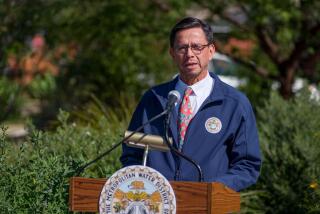Opinion: Are you an environmental enemy if you replace your lawn with fake grass?
How bad is California’s drought?
“Imagine a disaster movie in which 22 million people are told that they have only 12 to 18 months of water left. Unless Southern Californians pull together, we will be making that movie,” water scientist Jay Famiglietti wrote in a July op-ed article.
Given the severity of our drought and the calls to lower our water usage, it might make sense to replace our lawns with fake grass.
Not everyone agrees.
Just because it’s fake doesn’t necessarily mean it’s bad – a concept that shouldn’t be foreign to Angelenos
I just don’t get the fake-grass hate. Have you seen this stuff? From a distance it looks like closely mowed lawn. It provides a patch of green for play or lounging and doesn’t need watering or require sprinklers that always end up breaking and leaking. And, did I mention it’s easy to maintain? Because that is probably the single biggest selling point for artificial turf -- no work.
Lawn requires work. Native plants require work. Even rocks require work. I’ve lost so many Saturday hours pulling weeds out of our front yard of succulents and pea gravel. Fake grass only needs an occasional hosing. And one fewer weekend chore sounds pretty appealing.
I get that synthetic turf doesn’t provide the same water capture or ecological benefits of a soil-based landscape. And it would be bad for the environment if Los Angeles’ yards were be blanketed in fake grass. For that reason the city should reconsider whether artificial turf deserves the full $3.75-per-square-foot lawn replacement rebate, which is part of the water conservation program.
But there’s still a place for fake grass in L.A. Some homeowners want to look out their window and see a green yard. So if their choice is between keeping a water-guzzling lawn maintained by a polluting gas mower or laying down synthetic turf, fake grass is a good option.
Just because it’s fake doesn’t mean it’s necessarily bad. There are lots of innovations that are fake, but give consumers convenience or eco-, humane- or health-conscious choices. There’s pleather instead of leather for people who don’t use animal products. Meatless “chicken” nuggets. Composite or man-made “wood” for consumers concerned about deforestation. And don’t forget the fake Christmas trees -- that come already hung with lights already.
I know, some purists might mock these products as inauthentic, and fake grass also invites that kind of criticism. But I enjoy the fact that we have so many choices.
--Kerry Cavanaugh, editorial writer
There’s no sense in rolling out ugly plastic outdoor carpets that look like grass in a city like L.A.
You could move to Paris and go to Euro Disney every day and McDonalds for every meal, but what’s the point? You’re in Paris. Stop fighting it. Have a glass of wine. Enjoy.
It’s like moving to Southern California and trying to make your yard look like something from the English countryside by planting and watering a lush green lawn. What’s the point? You’re in Los Angeles.
Plant something that reflects the climate and the local rhythm of the seasons, not some fantasy or ancestral memory from another land. Plant something with the rich sagey scent of the local hills.
Besides, having a lawn in L.A. is wasteful. Back in Chatsworth or Devonshire -- the real ones, in the English Midlands, not the ones in the Valley -- the rolling lawn is the compensation for the incessant rain, and the mowing is done by the sheep. Here, a lawn is an expensive pain. Rip it out.
But if you’re going to rip it out, for heaven’s sake, don’t replace it with something fake that kind of, sort of, looks like grass from a distance. That’s like dining in France and trying to mold your French duck rillettes into the shape of a Big Mac.
There is one reason to roll out an ugly plastic outdoor carpet: People need a place to play baseball.
Fine, but it’s rug. Don’t try to make it look like grass. Don’t make it green. Be hot or be cold -- have lawn or have carpet, not one that is trying to look like the other.
We know how to do outdoor carpets in this town. People walk across them in the blazing sun while dressed in their evening clothes. If you’re going to replace your lawn with a carpet instead of drought-tolerant plants, make it an L.A. carpet. Make it red.
--Robert Greene, editorial writer
Fake grass is a terrible idea with serious consequences
This is the new Age of Aquarius -- an acute water-consciousness in Los Angeles.
And this should not be happening:
When the city is offering its people $3 a square foot to tear out their lawns and put in less thirsty substitutes, one of those substitutes should not be plastic grass.
Plastic grass -- “artificial turf,” to give it its more market-friendly name -- belongs, at best, in Easter baskets.
It does not belong in big chemical-green swaths stretched across the yards of Los Angeles.
Whatever it saves a homeowner in water, it costs us all in many other fashions.
Fake turf is a heat trap, creating “urban heat islands” with temperatures far higher than everything around it. As Columbia University research scientist Stuart Gaffin says, it’s the equivalent of “putting a parking lot around your house.” Is that what you want your kids playing on?
Phony grass can smother the soil, and with it, all the critters small and large that make the ecosystem work.
Synthetic turf feeds the destructive misperception that we live in a place with abundant water, a place entitled to lush greenswards, like Downton Abbey with palm trees.
Fake grass in backyards is another marker of L.A.’s miserable track record for creating public parks where real grass could arguably be put to economical, environmental and recreational use for thousands of people.
Bogus turf can be impermeable, like smearing even more concrete and asphalt over a city where the little rainwater we do get has fewer and fewer places to soak into the water table, where we desperately need it, and instead has to get wastefully sloughed off out the storm drains and into the ocean.
And phony lawns just invite more jokes about fake, plastic L.A.
Someone screwed up badly when artificial grass was included in the $3-a-square-foot water-saving lawn replacement plan. Mayor Garcetti, you can change this. This Angeleno doesn’t want to subsidize something that only perpetuates a problem we all need to fix.
We can rethink gardening as we take the bumpy path toward permanently reducing water use
A few years ago, there were some striking-looking caterpillars -- marked with thin stripes of yellow, black and white -- on a nondescript plant in the small planter outside the local library. They were the caterpillars of the monarch butterfly, a species whose reduced numbers have been causing concern. The plant they were munching away on was a narrow-leaf milkweed; monarch butterflies will lay their eggs only on milkweed plants, though any native variety of the plant will do.
I wondered if I could pull off this feat, so instead of planting more pansies in the pot on my walkway, I threw in a narrow-leaf milkweed. The result has been bumper crops of monarch caterpillars, several times a year. This past summer, there were too many caterpillars for too little milkweed food, so I donated some caterpillars to a co-worker with milkweed, and bought more of the plants myself.
This is one tiny story about ways in which we can rethink gardening as we take the bumpy path toward permanently reducing water use.
It’s unhelpful to get too prescriptive or judgmental about how we do that. Some people want play space for their kids, and a patch of artificial turf might be just the answer. Let’s remember that at first environmentalists were horrified by artificial Christmas trees, and ever since, the bottom line has seemed to shift back and forth about whether those are a better environmental solution or a worse one than the kind that shed needles. Given how much plastic we use in so many ways, then toss out without thinking, a plastic lawn that will last for many years doesn’t sound as though it’s a major contributor to our fossil-fuel-based pollution of the earth. Some people object to their looks, but so what? One person can’t stand the ivy that takes over someone’s hill, another can’t stand the smell of the society garlic in a median strip. For all the sprawl in this area, we’re rather cramped together, so we might as well get over holding our noses over every little aesthetic issue.
Still, it would be helpful for Southern Californians to realize that although we have built and paved through much of what used to be the natural home for birds, bugs and other creatures, we have an opportunity now to reverse direction just a little bit. As we redo gardens to be more water-frugal, we also can turn our yards into mini wildlife preserves. As the library planter shows, it doesn’t have to mean redoing an entire yard. A corner here, a few pots there. They would be a boon to our native fauna and a boost to our own sense of wonder about local nature. Another factor in their favor: Those plants are actually adapted to thrive in the lousy soil that pervades so much of the region.
But then, so is artificial turf, in its more modern and manufactured way.
--Karin Klein, editorial writer
Follow the Opinion section on Twitter @latimesopinion
More to Read
A cure for the common opinion
Get thought-provoking perspectives with our weekly newsletter.
You may occasionally receive promotional content from the Los Angeles Times.










